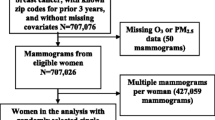Abstract
Increasing breast density is a risk factor for breast cancer. Geographic variations in breast density may be due to differences in lifestyle and diet, as well as environmental factors such as air pollution exposure. However, these environmental contributors have not been established. In this study, we evaluated an association between air pollution and mammographic breast density. The study population for this study was postmenopausal women who had undergone screening mammography at the Center for Preventive Medicine, St. Luke’s International Hospital, from April 2004 to September 2018. Individual mammography results were obtained from electronic charts. The ambient air pollution (PM2.5) density of the locations of interest, namely, the patients’ residential areas during the study period, was obtained. The mean PM2.5 exposure levels for 1, 3, 5, and 7 years were determined. A generalized estimating equations model was used to examine the association between air pollution density and dense breast. A total of 44,280 mammography results were included in this study, and 29,135 were classified in the non-dense breast group and 15,145 in the dense breast group. There was a 3% increase in the odds of having dense breasts after 1 year (OR = 1.027, 95% confidence interval (CI) 1.019–1.034) and 3 years of PM2.5 exposure (OR = 1.029, 95% CI 1.022–1.036). This further increased to 4% at 5-year exposure (OR = 1.044, 95% CI 1.037–1.052) and 5% at 7-year exposure (OR = 1.053, 95% CI 1.044–1.063). The risk for dense breasts increased if the factors of smoking, family history of breast and/or ovarian cancer, and history of childbirth were present.
Similar content being viewed by others
Data availability
Individual patient data are not available to maintain confidentiality.
References
Andersen et al (2017) Long-Term exposure to ambient air pollution and incidence of postmenopausal breast cancer in 15 european cohorts within the ESCAPE project. Environ Health Perspect 125(10):107005. https://doi.org/10.1289/EHP1742
Bell ML et al (2007) Spatial and temporal variation in PM(2.5) chemical composition in the United States for health effects studies. Environ Health Perspect 115(7):989–995. https://doi.org/10.1289/ehp.9621
Boyd NF et al (1999) Mammographic densities and risk of breast cancer among subjects with a family history of this disease. JNCI: J Natl Cancer Inst 91(16):1404–1408. https://doi.org/10.1093/jnci/91.16.1404
Boyd NF et al (2002) Heritability of mammographic density, a risk factor for breast cancer. N Engl J Med 347(12):886–894. https://doi.org/10.1056/NEJMoa013390
Buschini A et al (2001) Urban airborne particulate: genotoxicity evaluation of different size fractions by mutagenesis tests on microorganisms and comet assay. Chemosphere 44(8):1723–1736. https://doi.org/10.1016/s0045-6535(00)00550-6
Cheng et al (2019) Association between ambient air pollution and breast cancer risk: The Multiethnic Cohort Study. Int J Cancer 146(3):699–711. https://doi.org/10.1002/ijc.32308
Dorgan JF et al (2013) Menstrual and reproductive characteristics and breast density in young women. Cancer Causes Control: CCC 24(11):1973–1983. https://doi.org/10.1007/s10552-013-0273-2
DuPre NC et al (2017) Residential particulate matter and distance to roadways in relation to mammographic density: results from the Nurses Health Studies. Breast Cancer Res 19(1):124. https://doi.org/10.1186/s13058-017-0915-5
Hamra GB et al (2014) Outdoor particulate matter exposure and lung cancer: a systematic review and meta-analysis. Environ Health Perspect 122(9):906–911. https://doi.org/10.1289/ehp/1408092
Heller SL, et al (2018) Hormonal effects on breast density, fibroglandular tissue, and background parenchymal enhancement. Radiographics : a review publication of the Radiological Society of North America, Inc 38(4):983–996. https://doi.org/10.1148/rg.2018180035
Japan Statistics Bureau (2022) Movements between prefectures by age in 2019. Available at: https://www.stat.go.jp/info/today/155.html. Accessed 2 Nov 2022
McCormack VA, dos Santos Silva I (2006) Breast density and parenchymal patterns as markers of breast cancer risk: a meta-analysis. Cancer Epidemiol Biomarkers Prevent A Publication Am Assoc Cancer Res Cosponsored Am Soc Preventive Oncol 15(6):1159–1169. https://doi.org/10.1158/1055-9965.EPI-06-0034
Nakajima E et al (2020) Association of parity and infant feeding method with breast density on mammography. Acad Radiol 27(2):e24–e26. https://doi.org/10.1016/j.acra.2019.03.020
Ramón y Cajal T et al (2015) Mammographic density and breast cancer in women from high risk families. Breast Cancer Res 17(1):93. https://doi.org/10.1186/s13058-015-0604-1
Villenueve et al (2018) Residential exposure to fine particulate matter air pollution and incident breast cancer in a cohort of Canadian women. Environmental Epidemiology 5:e021, 1–8
White et al (2019) Air pollution, clustering of particulate matter components, and breast cancer in the sister study: A U.S.-Wide Cohort. Environ Health Perspect 127(10):107002–1–107002–9
Yaghjyan L et al (2017) Association between air pollution and mammographic breast density in the Breast Cancer Surveilance Consortium. Breast Cancer Res 19(1):36. https://doi.org/10.1186/s13058-017-0828-3
Author information
Authors and Affiliations
Contributions
Conceptualization: ML and RK; methodology: ML, HY, TK, HT, and RK; formal analysis and investigation: ML, HY, TK, HT, and RK; writing—original draft preparation: RK; writing—review and editing: ML and RK.
Corresponding author
Ethics declarations
Ethics approval
This study was approved by the Research Ethics Board at St. Luke’s International Hospital.
Consent to participate
Written consents were acquired by study participants.
Consent for publication
All authors agreed with the publication of the content.
Conflict of interest
The authors declare no competing interests.
Additional information
Responsible Editor: Lotfi Aleya
Publisher's note
Springer Nature remains neutral with regard to jurisdictional claims in published maps and institutional affiliations.
Rights and permissions
Springer Nature or its licensor (e.g. a society or other partner) holds exclusive rights to this article under a publishing agreement with the author(s) or other rightsholder(s); author self-archiving of the accepted manuscript version of this article is solely governed by the terms of such publishing agreement and applicable law.
About this article
Cite this article
Kotake, R., Yamauchi, H., Kimura, T. et al. An association between mammographic breast density and fine particulate matter among postmenopausal women. Environ Sci Pollut Res 30, 25953–25958 (2023). https://doi.org/10.1007/s11356-022-23529-0
Received:
Accepted:
Published:
Issue Date:
DOI: https://doi.org/10.1007/s11356-022-23529-0



